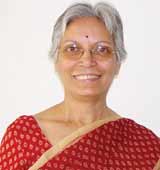|
Executive Interviews: Interview with Kamal Singh on Women Executives
July 2007
-
By Dr. Nagendra V Chowdary
 Kamal Singh
Kamal Singh working with the British Council as Head, Governance & Social Justice, India. 
Thank you,Ma'm, for having agreed
to be Interviewed. And also
congratulations for your scholastic
achievements. Can you briefly share
with us your areas of work and
important milestones that you have
achieved?
I started working with the British
Council in 1975 but realized in the
early 1980s that if I wanted my
career to grow then I needed a postgraduate
qualification, just the work
experience was not going to be
sufficient. I analyzed the kind of
openings on offer and that were of
interest to me, and then did Masters
in Public Administration.
International events and training
have further honed up my skills.
|
|
My
key areas of work in the last 18 years
have been gender equality and
diversity, child rights, law and
human rights, police reforms, civil
service and public sector reforms,
and recently corporate social
responsibility. The British Council's
mandate is to share UK's experience
and trends with Indian partners in
areas of mutual interest. This has
meant being on a learning curve, as I
need to first understand the UK and
international context and then build
up my knowledge and networks at
the Indian end. I have found this
challenging and professionally
rewarding. -
How good are women as
entrepreneurs? Why don't we see
more Indian women entrepreneurs?
We do have very few Shehnaz
Hussians, Kiran Mazumdar Shahs,
Anu Agas and many more smalltime
entrepreneurs. But the big
league is missing in India. What
seems to be lacking are stories of
first-generation women
entrepreneurs, or those who
swerved from their father's business
to stand on their own. What does it
take to create that pool of big-time
entrepreneurs?
I think women make excellent
managers, as they learn early in life
to balance several resources for
success, for example, time, ideas,
finance and relationships. But there
haven't been enough role models to
emulate. Its worth exploring the
historical reasons of the low status
of Indian women, for example, on
indicators of health, education and
economic participation. Gender
division of labor shows that
women's work is not valued in
economic terms. Women have
entered the formal workforce at
managerial levels only recently. In
the informal sector they have been
involved in subsistence activities,
mainly with an effort on survival;
their baseline has been low skills and
low wages, and not sufficient
opportunities for growth or access to
resources. However, as the last
census shows, female literacy rate is
improving. School results show girls
are outperforming boys and are
joining courses that were earlier
assumed to be reserved only for boys.
In the early 1990s, in our work with
the public sector, we were repeatedly
told that there were not sufficient
women above the supervisory level
to be trained inUK. Its nowchanging,
and there are many bright sparks
who will emerge as entrepreneurs—
it was only a matter of time, and the
time has now come. -
An ILO report on Women
Entrepreneurs revealed, "Women
have a proportionately greater
presence in the informal economy
and in micro-enterprises; and they
are less represented in formal,
registered SMEs."Why is it so?
In 1992 British Council, in
collaboration with Indian Institute of
Management Ahmedabad, organized
a regional workshop on development
of micro-enterprises by women. A
group of 40 academics and NGOs
from India, Nepal, Bangladesh,
Pakistan and Sri Lanka jointly shared
experiences on how income
generating activities are a major entry
point for NGOs concerned with
women's development. Reports from
all countries were same as the ILO
Report you mention. It was
recognized that women's economic
empowerment was a powerful
precursor to women's empowerment.
Micro-enterprises have helped
women address issues of poverty and
debt, usually managed by one person,
but sometimes contributing to a larger
group effort for strength and survival.
Without access to adequate education
or trainingwomenhave relied on their
household and creative skills as well
as community needs to do activities
that would generate an income to
enable them to meet household
expenses. Research has also shown
that women tend to spend their
earnings on household needs, child
education and health, whereas men
spend more on consumption and
personal items. Iwould attribute three
reasons for lesser number of women
in the formal sector: 1) lack of
education and training, hence less
opportunities for women 2) even
when opportunities existed, these
were often denied to women as the
concept of equality enshrined in our
Constitution was not being practiced
3) saturation of the wage employment
sector, which limited entry
opportunities for women as they were
not recognized as primary wage
earners and a gender bias existed
amongst employers. To add to that, women's economic
activities were earlier perceived as
"supporting" the main wage earner,
always assumed to be the male.
Women's "caring" role was not
recognized, whether it was care of the
young or care of the elderly,within the
family orwithin communities. Despite
these barriers, the success of self-help
groups (SHGs) and micro-enterprise
development have shown women's determination to come out of poverty
conditions and improve their lives.
1.
Women's Western Wear Market Case Study
2. ICMR
Case Collection
3.
Case Study Volumes
|
